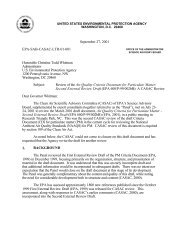(CASAC) Peer Review of EPA's Integrated Science Assessment
(CASAC) Peer Review of EPA's Integrated Science Assessment
(CASAC) Peer Review of EPA's Integrated Science Assessment
Create successful ePaper yourself
Turn your PDF publications into a flip-book with our unique Google optimized e-Paper software.
confidence limits for the ED50 in this case) The Linn et al. data also indicate a slightlygreater amount <strong>of</strong> interindividual variability than those <strong>of</strong> Horstman—a geometricstandard deviation <strong>of</strong> 2.85 with 90% confidence limits <strong>of</strong> 2.10-5.75. Together, if weassume a lognormal distribution <strong>of</strong> individual thresholds as before, the central estimate <strong>of</strong>interindividual variability and the central estimate <strong>of</strong> the ED50 from the Linn et al datawould indicate that 95% <strong>of</strong> exercising asthmatics should have this response at between104 and 3250 ppb. Unfortunately, there is reason to doubt that the distribution isperfectly lognormal—a goodness <strong>of</strong> fit test indicates a barely statistically significantdeparture <strong>of</strong> the data from expectations from a lognormal model at P < .05.There are a couple <strong>of</strong> ways to combine these data for an aggregate analysis. One simpleway that I did was to add the Horstman observations where they would fall in thehistogram-like data from the Linn et al. papers. When this is done, the ED50 indicatedby the combined data is just under 700 ppb and the geometric standard deviation forinterindividual variability is 2.52 with 90% confidence limits <strong>of</strong> 2.01-3.83. The revisedcentral estimate ED50, combined with the central estimate <strong>of</strong> the geometric standarddeviation would indicate that 90% <strong>of</strong> exercising asthmatics should respond between 150and 320 ppb. Again, however, the combined data depart from expectations <strong>of</strong> alognormal distribution model at a P level <strong>of</strong> slightly less than 0.02. In further exploration<strong>of</strong> the combined data (including experiments <strong>of</strong> other research groups) I wouldrecommend an attempt to fit a mixture <strong>of</strong> two lognormal distributions. I could notattempt this in this analysis, however because a mixture <strong>of</strong> two lognormals involvesestimation <strong>of</strong> 5 parameters (two means, two standard deviations and a parameter tomeasure the fraction <strong>of</strong> the population that belongs to each component distribution) andthe Linn et al. data are aggregated only into 4 ranges. There is likely to be an infinitenumber <strong>of</strong> perfect-fit solutions when one uses only 4 data points to estimate 5 parameters.If it is <strong>of</strong> interest to EPA staff, I will provide the Excel spreadsheet showing thesecalculations.ReferencesHaas, C. N. "Dose Response Analysis Using Spreadsheets" Risk Analysis 14:1097-1100(1994).Hattis, D., Russ, A., Goble, R., Banati, P., and Chu, M. “Human InterindividualVariability in Susceptibility to Airborne Particles,” Risk Analysis, Vol. 21(4), pp. 585-599 (2001).16
















